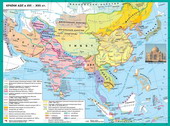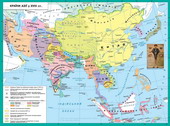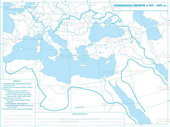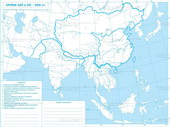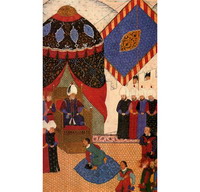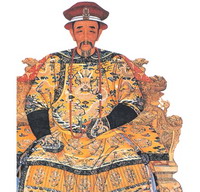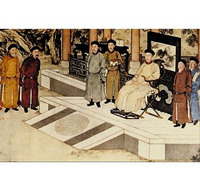Orient in XVI - XVIII centuries.
Meanwhile in Europe there were violent changes, the East, from the perspective of Europeans lived a life measured. During early modern times continued to develop three major civilizations East: Middle Eastern, Muslim, covering North Africa, the Middle East, Indian-South Asian, which included the Hindustan peninsula and adjacent territory, and China-Far East, covering the territory of China, Indochina , Korea, Japan.
powerful nation the world was the Muslim Ottoman Empire, which at the beginning of XVI century. occupied territory of the Balkan Peninsula and Asia Minor. By the end of XVII century. The Ottoman empire continued to expand its borders. The top internal and external power is on the empire of the Sultan Suleiman I (1520-1566 biennium). In Turkey, Suleyman situation was stable, and military campaigns Kafirs several successes. The territory of his empire throughout Europe exceeded. Europeans, although fear of a powerful sultan, still gave tribute to his military and civil achievements, calling him Suleiman Magnificent. Most Turks gave him the nickname Kanuni ("legislator"). Large influence on Suleiman I, as evidenced by contemporaries, his wife made an Roksolana, according to legend - Ukrainian, who was kidnapped by the Tatars in captivity.
In years of Suleiman and it was difficult to predict the future decline of the empire. Breakthrough was the battle of Vienna in 1683 that after the Ottoman Empire began to lose territory. Slowly gaining strength liberation movement conquered nations, increased domestic problems. It was clear that in the future empire collapsed.
India from time immemorial varied weave of different peoples, languages, religions, cultures and traditions. The main area occupied by the independent states of India. Them ruled Maharaja (king) or Raja (Prince). Most of India's population lived in villages, where all were community and caste principle of separation of populations dopovnyav and strengthened it. Proud of her country were the cities which struck the imagination of Europeans, their grandeur, beauty and wealth. Products of Indian artisans in demand outside India. Trade Raja gave huge profits. This wealth of India have led to fundamental changes the fate of the country. In the XVI century. in the coastal city got the Europeans, and from northern India invaded the Central Asian Mughals led by Babur.
Babur was a descendant of Genghis and Timur, ruled the Fergana, and later took over Kabul. Babur, with a strong army equipped with artillery in a battle near Panipata (1526) defeated the Delhi Sultan's army. This date is considered the beginning of the establishment of the Mughal state, which lasted 200 years.
Babur's grandson Akbar (1556-1605rr.) won the North and Central India and Afghanistan. Akbar introduced a unified system of centralized power, tough taxation, made military reform. Even tried to create a new religion. According to the State Board of Akbar was the Mughal Empire Mughal. Under the successors of Akbar the borders of the empire continued to expand in late XVII century. included almost all of India. In the empire flourished trade and crafts, her beautiful decorated city buildings and churches, which combined the traditions of Islamic and Indian architecture. The most famous building of that era - is the mausoleum of the Taj Mahal in Agra.
But Sultan Aurangzeb (1658-1707 biennium) were to show signs of crisis. Although the Mughals were Muslims, they are in the period of his reign, kept religious tolerance. Fanatical Aurangzeb violating religious peace rozhytav foundation and stability of the empire is on the verge of XVII-XVIII centuries. it breaks up into separate principalities.
the time significantly increased European influence in India.
Founded in 1600 in the English East India Company almost supplanted the great port cities of India, the Portuguese and Dutch merchants. In the XVIII century. She led an active attack on the French possession in India. In the battle near Pleso (1757) inflicted a decisive defeat of the British Indian rulers, and began to conquer the country. The rulers of the Mughal Empire, which was split could only watch this bezuchasno.
China is one of the oldest and nayzaselenishyh countries. Having survived not one evil, China maintained the stability and tradition. After liberation from Mongol oppression in 1368 in China acutely dynasty (1368-1644 biennium). For her, the country has strengthened its trade, agriculture and handicrafts, there developed in urban factory. In Europe, highly tsinylasya Chinese porcelain, fabrics, jewelry, tea, spices. Chinese cities with their unusual architecture of the Europeans has always impressed travelers. In cities of China was still the Middle Ages were banks, pawnshops, etc. Mint.
In the 20 st century XVII. internal and external situation has deteriorated Ming Empire. Anarchy in the country grew in intensity caused by the endless struggle for power among the ruling elite. Excess tax ruined the economy of farmers. In addition, countries struck natural disasters: drought and floods zminyaly each other locusts destroying crops. Desperate peasants rose up to fight. The country began peasant war (1628-1645 biennium).
peasant rebels captured Beijing and declared its leader Li Tszychena emperor. But in that time the country has suffered invasion Manchus, nomadic tribes living north of China. In 1644 Manchus captured Beijing. This event is the start of the Manchu Qing dynasty (1644-1911 biennium). Manchu behaved as conquerors, showing its superiority over the Chinese, although not posyahaly on tradition and religion of the country and even their followers.
Wealth China attracted Europeans. From the XVI century. China to penetrate the European merchants and missionaries. The growing influence of Europeans was the Manchu rulers of trouble (bohdyhaniv). With the country were sent missionaries, and from 1757 China was closed to Europeans in general.
 English
English

